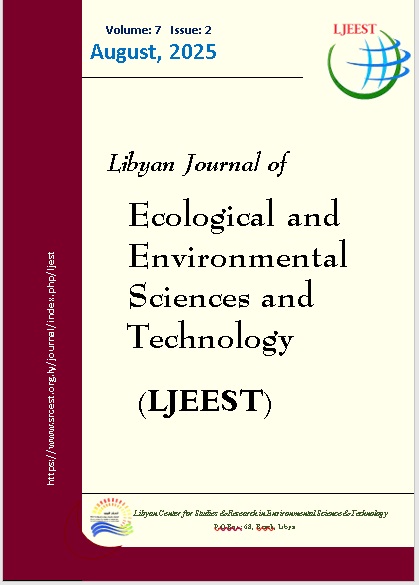Estimation of the amount of degradation of Juniperus phoenicea trees and its relationship to environmental factors in several sites of the Al-Jabal Al-Akhdar -Libya
DOI:
https://doi.org/10.63359/kzzwc781Keywords:
Juniperus phoenicea, Deterioration, Environmental factors, Al-Jabal AlAkhdar, LibyaAbstract
This study was conducted on the Juniperus phoenicea L. in the Al-Jabal Al-Akhdar region in two phases. In the first phase, a field survey was carried out in 2016 across several juniper forests located in the central part of the Al-Jabal Al-Akhdar. The study included various sites at different elevations, such as Soussa, Ras Al Hilal, Al-Hamamah, Al-Wasita, Qasr Al-Muqaddam, Bel-Hadid, Belghrai, Wadi Al-Kouf, and Al-Bayda. The results revealed a variation in infection rates among the sites. When calculating the infection percentages, it became evident that most locations showed high rates exceeding 90%, with the exception of Qasr Al-Muqaddam and Al-Bayda, which recorded lower rates of 46.8% and 68.0%, respectively. The highest severity of infection was noted in Wadi Al-Kouf and Belghrai, with 60.9% and 64.0%, respectively. Moderate infection severity ranging from 47% to 55% was observed in Ras Al Hilal, Al-Wasita, and Bel-Hadid, while the remaining areas recorded lower severity levels below 35%. The second phase focused on monitoring the decline of Juniperus trees across three terraces located at different elevations throughout the four seasons of 2017. These terraces were Al-Hamamah, situated at approximately 40 meters above sea level; Al-Wasita, at about 290 meters; and Wadi Al-Kouf, located around 600 meters above sea level. Environmental and climatic factors, including temperature, relative humidity, and physical and chemical soil properties, were measured at each site to identify the causes of juniper mortality. The results indicated a seasonal variation in infection rates across the three locations. The highest infection rate was recorded in summer at Wadi Al-Kouf, reaching 89.83%, whereas the lowest was observed in spring at Al-Hamamah, at 49.03%. Infection severity followed a similar pattern, with the highest values also occurring in summer: 78.47% in Wadi Al-Kouf, 65.70% in Al-Hamamah, and 63.07% in Al-Wasita. In contrast, spring recorded the lowest severity, particularly in Al-Wasita, where it did not exceed 30.80%. The study concluded that unfavorable climatic conditions, especially high temperatures in summer, played a significant role in the accelerated decline of juniper trees. Wadi Al-Kouf was identified as the most affected site during the summer season. Furthermore, analysis of disease progression showed a clear relationship between juniper mortality and environmental factors. Pearson’s correlation coefficient (r) revealed a moderate relationship between infection rate and severity with temperature in 2016, a moderate correlation between infection rate and seasonal changes, a moderate correlation between infection rate and temperature, and a strong correlation between infection severity and temperature in 2017.
References
الزوام. (1984). كتاب الجبل الاخضر دراسة في الجغرافية الطبيعية. 119.
العمروني, ح. ع., & مجيد, م. (2015). دراسة بيئية لنبات العرعر الفينيقى بمنطقة الجبل Juniperus phoenicea L. الأخضر.
الزني, ا. ا. ع., & بيومي, ب. م. ع. (2006). الأشجار والشجيرات الهامة المحلية والمستوردة بالجبل الأخضر ،ليبيا. الدار الأكاديمية للطباعة والتأليف والترجمة والنشر،.
الهيئة العامة للبيئة، التقرير الوطني الرابع حول تنفيذ اتفاقية التنوع الحيوي. (2010). طرابلس ليبيا.
تقرير دراسة وتقييم الغطاء النباتى الطبيعى بمنطقة الجبل الأخضر. (2005). جامعة عمر المختار، مشروع الجبل الأخضر، التقرير النهائي.
رمضان, ب. م. خ. (1995). الترب الليبية: (تكوينها - تصنيفها - خواصها - إمكانياتها الزراعية). جامعة الفاتح،.
زعطوط, إ. ع., & محمد, ن. ع. (2024). عزل وتعريف فطر Rhizoctonia solani من أوراق وأفرع أشجار العرعر الفينقي Juniperus phoeniceaبمنطقة الوسيطة-الجبل الأخضر-ليبيا. المجلة الليبية لعلوم وتكنولوجيا البيئة (م ل ع ت ب), 6(2), A27-31. https://doi.org/10.63359/ey139383
زعطوط, إ. ع., زعطوط, م. م., المزيني, ص. خ., المنصوري, م. ط., & عبد السلام بوماضي, م. (2025). حصر وتقييم حالات الإصابات المرضية للأنواع الشجرية والشجيرية الإبرية وعريضة الأوراق داخل محيط مجمع كليات الفتائح جامعة درنة-ليبيا. Arabian Journal of Scientific Research, 2025(1), 4. https://doi.org/10.5339/ajsr.2025.4
شعيب، يونس حمد. (2009). تحسين جودة أحد مواقع غابات العرعر الفينيقي المتدهورة بالجبل الأخضر وطريقة لتحوير الغطاء الغابي، دراسة مقدمة لاستكمال متطلبات الإجازة العالية (الماجستير) غير منشورة، جامعة عمر المختار، البيضاء، ليبيا.
Ahmed, M., Shaukat, S. S., & Buzdar, A. H. (1990). Population structure and dynamics oi Juniperus excelsa in Balouchistan, Pakistan. Journal of Vegetation Science, 1(2), 271–276. https://doi.org/10.2307/3235664
Al-Sodany, Y. M., Shehata, M. N., & Shaltout, K. H. (2003). Vegetation along an elevation gradient in Al-Jabal Al-Akhdar, Libya. Ecologia Mediterranea, 29(2), 125–137. https://doi.org/10.3406/ecmed.2003.1547
Andrews, G. (1998). The use of trees and shrubs for livestock production. Australian Biologist, 11(2), 4.
Aref, I. M., & El-Juhany, L. I. (2000). Natural and planted forests in Saudi Arabia; their past present and future.
Clifton, S. J., Ward, L. K., & Ranner, D. S. (1997). The status of juniper Juniperus communis L. in northeast England. Biological Conservation, 79(1), 67–77. https://doi.org/10.1016/S0006-3207(96)00101-2
Commission, N. Resources. S. S. (2001). IUCN Red List categories and criteria. IUCN.
Darbyshire, I., Lamb, H., & Umer, M. (2003). Forest clearance and regrowth in northern Ethiopia during the last 3000 years. The Holocene, 13(4), 537–546. https://doi.org/10.1191/0959683603hl644rp
Diamond, D. D., Rowell, G. A., & Keddy-Hector, D. P. (1995). Conservation of Ashe juniper (Juniperus ashei Buchholz) woodlands of the central Texas Hill Country.
El-Barasi, Y. M., Barrani, M. W., El-Amrouni, A. O., & Mohamad, N. F. (2011). Check list of flora and vegetation on south Elmarj zone: South El-jabal EL-Akhadar-Libya. Annals of the Faculty of Engineering Hunedoara, 9(3), 141.
Esper, J., Bosshard, A., Schweingruber, F. H., & Winiger, M. (1995). Tree-rings from the upper timberline in the Karakorum as climatic indicators for the last 1000 years. Dendrochronologia, 13, 79–88.
Fisher, M. (1997). Decline in the juniper woodlands of Raydah Reserve in southwestern Saudi Arabia: a response to climate changes? Global Ecology and Biogeography Letters, 379–386. https://doi.org/10.2307/2997338
Fisher, M., & Gardner, A. S. (1995). The status and ecology of a Juniperus excelsa subsp. polycarpos woodland in the northern mountains of Oman. Vegetatio, 119, 33–51. https://doi.org/10.1007/BF00047369
Gomez, K. A., & Gomez, A. A. (1984). Statistical procedures for agricultural research. John wiley & sons.
Guyot, J., Condina, V., Doaré, F., Cilas, C., & Sache, I. (2010). Segmentation applied to weather-disease relationships in South American leaf blight of the rubber tree. European Journal of Plant Pathology, 126, 349–362. https://doi.org/10.1007/s10658-009-9540-1
Hajar, A. S. (1991). Germination studies of Juniperus excelsa from South-western Sauda Arabia. Indian Botanical Contactor, 8(1), 41–44.
Herzog, M. (1998). Shrubland Management in Tribal Islamic Yemen: Social Forestry as Development of a Local and Sustainabel (sylvi-) culture: an Essay in Practical Philosophy. Verlag nicht ermittelbar.
Horsfall, J. G., & Heuberger, J. W. (1942). Measuring magnitude of a defoliation disease of tomatoes. Phytopathology, 32(2), 226–232.
James, W. C. (1971). An illustrated series of assessment keys for plant diseases.
Miskell, J. E. (2000). An Ecological and Resource Utilisation Assessment of Gacaan Libaax, Somaliland. IUCN Eastern Africa Regional Office.
Otta, J. D., Fiedler, D. J., & Lengkeek, V. H. (1980). Effect of benomyl on Phomopsis juniperovora infection of Juniperus virginiana. Phytopathology, 70(1), 46–50.
Roberts, D. L. (2009). The Plant Doctor’s LANDSCAPE TIPS Phomopsis of blight juniper: Michigan State University Extension The Landsculptor – June 2009 13, PP1.
Weber, D. J., Bunderson, E. D., Davis, J. N., Nelson, D. L., & Hreha, A. (1999). Diseases and Environmental factors of the pinyon-juniper communities. Proceedings: Ecology and Management of Pinyon-Juniper Communities within the Interior West, 118–120.
Wilkins, T., & Duckworth, J. C. (2011). Breaking new ground for juniper: a management handbook for lowland England. Plantlife.
Zaetout, A. A., Abdlrahman, A. Y. F., Alhasaa, N. S., Bin Zabiya, F. N., & Alsalheen, S. A. (2024a). The first report on the green stink bug nezara viridula on trees Juniperus oxycedrus subsp. macrocarpa in Derna City-Libya. North African Journal of Scientific Publishing, 2(1), 29–34. https://najsp.com/index.php/home/article/view/136
Zaetout, A. A., & Mohamed, N. A. (2024b). A study on carob leaf spot disease and the impact of environmental on its spread in AL-Jabal AL-Akhdar-Libya. African Journal of Advanced Pure and Applied Sciences (AJAPAS), 30–39. https://aaasjournals.com/index.php/ajapas/article/view/675
Zatout, A. A., Mohamed, N. A., & Saeed, M. A. (2023). Record of Sordaria fimicola Causing Dieback on Juniperus phoenicea in Al-Jabal Al-Akhdar–Libya. Al-Mukhtar Journal of Sciences.;38(2):173–179. 8 https://doi.org/10.54172/mjsc.v38i2.644
Zaetout AA, Zaatout MM, Al-Muzaini SK, Al Mansouri MT, Boumadi MA. (2025). Survey and assessment of disease infections in needle-leaved and broad-leaved tree and shrub species within Al-Fatiah Campus, University of Derna- Libya. Arabian Journal of Scientific Research 6:1.4. https://doi.org/10.5339/ajsr.2025.4
Downloads
Published
Issue
Section
License
Copyright (c) 2025 Libyan Journal of Ecological & Environmental Sciences and Technology

This work is licensed under a Creative Commons Attribution-NonCommercial 4.0 International License.















